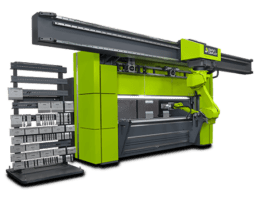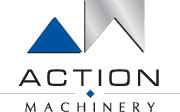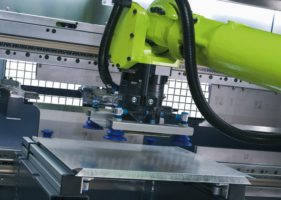
Press Brake Automation Advantages
Press brake automation has become important in modern manufacturing due to its many benefits
Better productivity
Automated press brakes cut down setup time and increase production rates, helping manufacturers meet demand. They can work non-stop, producing more without losing quality.
Higher precision
Automation removes human error, leading to better bends and complex shapes. Advanced software helps press brakes work with great accuracy, resulting in better products.
Lower labor costs
Automation saves on labor costs while keeping output consistent. This reduces production costs and lets companies use workers for more important tasks, encouraging growth.
Robotics in Press Brake Automation
Robots improve press brake automation by adding even more precision and efficiency:
Robotic Bending Cells
These systems combine a press brake with a robot to automate material loading, bending, and unloading. They can be customized for specific needs, making them flexible for manufacturers.
Adaptive Bending Solutions
Advanced sensors allow robots to adjust to material changes, ensuring accurate bending. This helps maintain consistency even with difficult materials or complex shapes.
Collaborative Robots (Cobots)
These robots work with human operators, integrating into existing workflows and boosting productivity. Cobots have safety features for working near humans, keeping efficiency high while retaining a human touch.
New Technologies Impacting Press Brake Automation & Robotics
Several new technologies are changing the world of press brake automation and robotics:
Artificial Intelligence (AI) & Machine Learning
AI algorithms optimize bending and predict errors, helping manufacturers fix issues and be more efficient. Machine learning uses data to find patterns and trends, allowing for ongoing improvements.
Internet of Things (IoT) & Industry 4.0
Connecting machines to a network enables monitoring, maintenance, and data-driven decisions, making manufacturing smoother. IoT and Industry 4.0 create smart factories where everything works together, maximizing productivity and minimizing downtime.
Augmented Reality (AR)
AR helps operators set up and program press brakes, cutting down training time and ensuring the best performance. AR shows digital information in the real world, making complex bending tasks easier to understand and complete.
The Future of Manufacturing with Press Brake Automation & Robotics
As technology advances, press brake automation and robotics will become even more important in manufacturing. Some future trends include:
More customization
Advanced automation and robotics will allow manufacturers to create personalized products for customers, opening new markets and setting them apart from competitors.
Sustainable manufacturing
Automated machines and robots can help reduce waste, save energy, and use raw materials wisely. This will be important for businesses that want to be environmentally friendly.
Workforce changes
As automation and robotics become more common, workers will need to learn new skills. Training programs will be essential for helping employees adapt to new technologies.
 Global competitiveness
Global competitiveness
Companies using press brake automation and robotics will have a competitive edge in the global market. By increasing efficiency, reducing costs, and offering customized products, these businesses will be better positioned to succeed.
In conclusion, the future of manufacturing will be heavily influenced by the ongoing advancements in automation and robotics. These technologies offer numerous advantages, such as increased productivity, higher precision, lower labor costs, and more sustainable practices. By integrating AI, IoT, Industry 4.0, and AR, manufacturers can create smart factories that are efficient, adaptive, and environmentally friendly.
The success of businesses in the manufacturing sector will be closely tied to their ability to embrace and integrate these innovations. Companies that invest in automation and robotics will be better positioned to compete globally, offer customized products, and adapt to changing workforce requirements. As a result, the future of manufacturing will be defined by the effective implementation of automated press brakes and robotics.
 Action Machinery
Action Machinery 